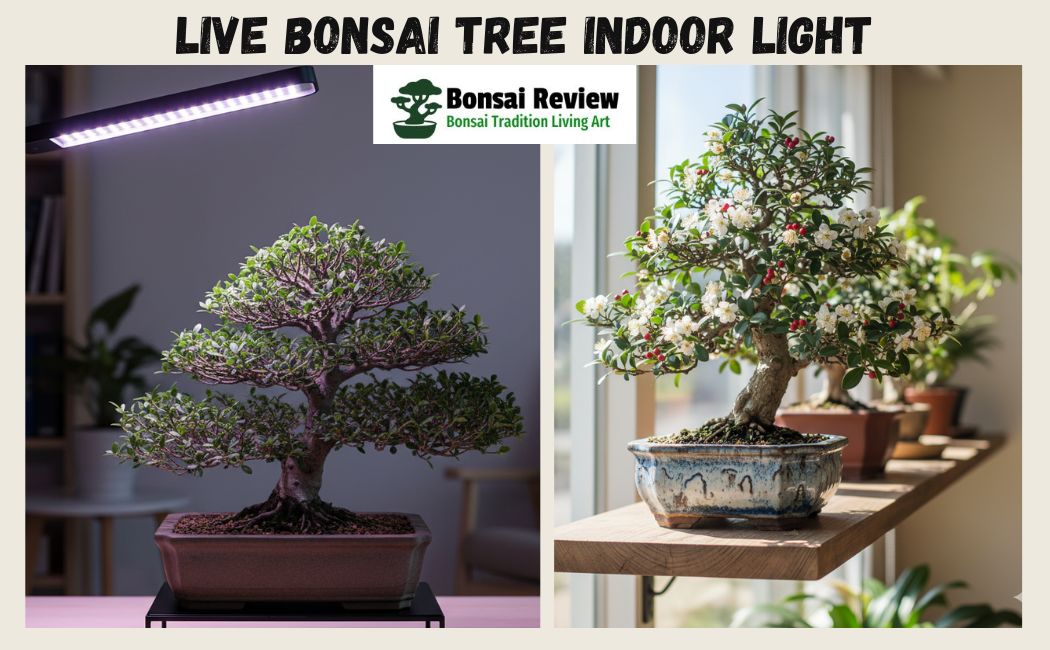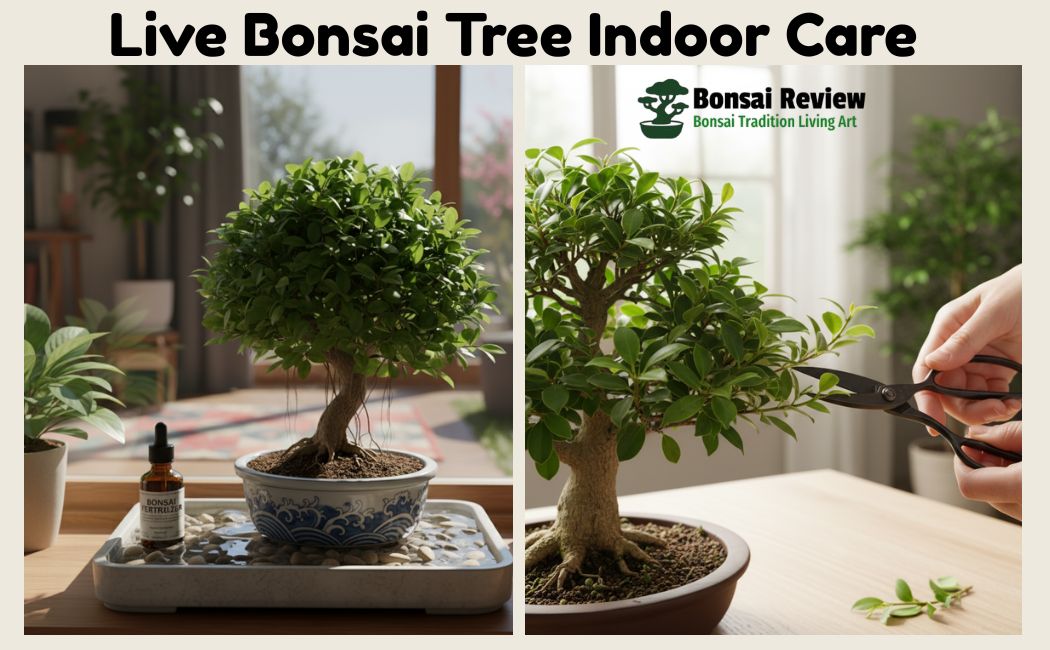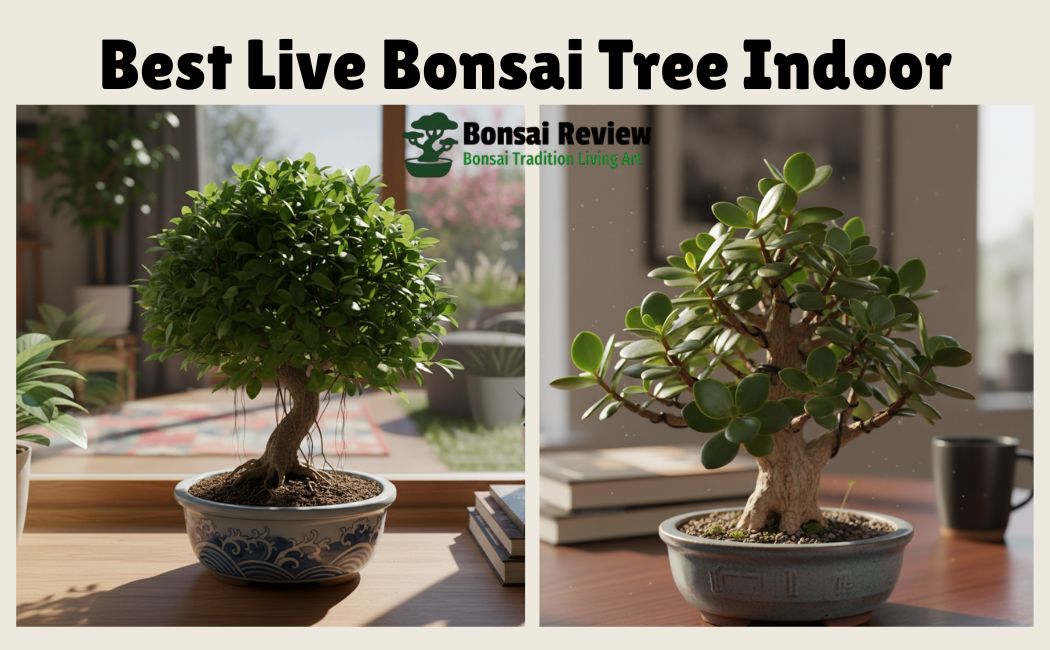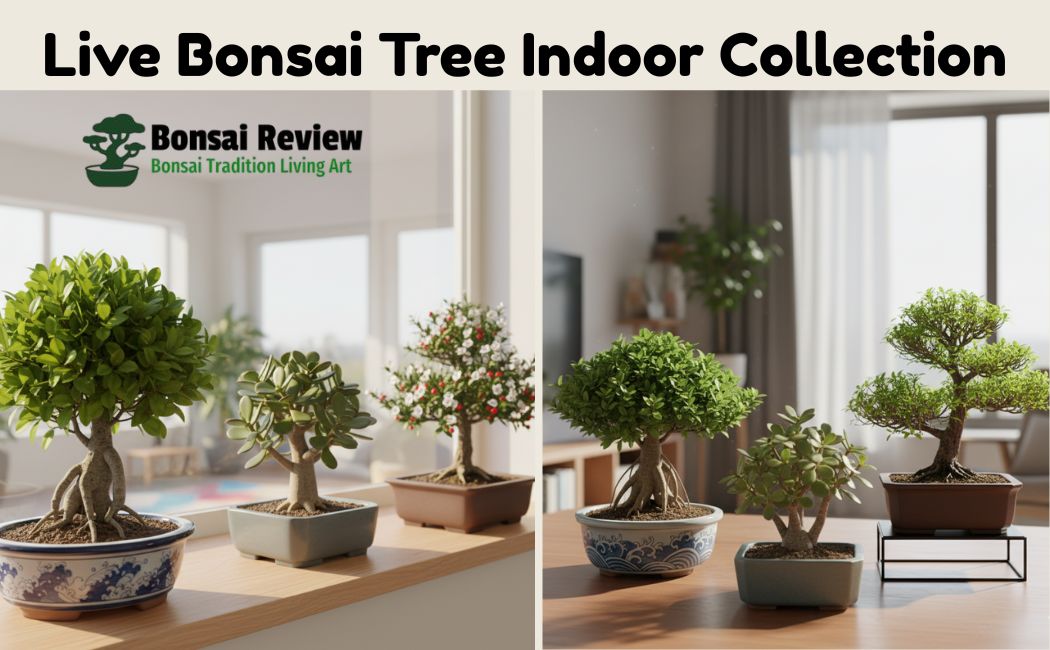If you’re searching for a live bonsai tree indoors, the first thing you need to know is that not every species can survive inside. Tropical and subtropical bonsai trees like Ficus bonsai (Golden Gate Ficus, Ficus microcarpa, or Ficus ginseng).
Dwarf Jade bonsai (also called Baby Jade or Elephant Bush), and Chinese Elm bonsai are some of the best indoor bonsai trees for beginners because they handle low light and indoor air better than Juniper bonsai or Pine bonsai, which must stay outdoors.
Some people also love the Hawaiian Umbrella bonsai (Schefflera arboricola) or the flowering Fukien Tea bonsai, which can surprise you with small white blooms.
You’ll often see these trees for sale online at trusted shops. Sometimes marked on sale with fast shipping like “get it by Fri.” Prices range widely, from starter bonsai under $100 to collector trees worth over $2,000, and many listings include reviews, so you can make informed choices with confidence.
If you want a flowering bonsai, a fruit-bearing bonsai like citrus or cherry, or a small evergreen bonsai. The key is choosing the right species for your indoor zone and following proper care steps, including light, watering, humidity, pruning, and repotting, so your bonsai grows strong and stays beautiful.

Which Live Bonsai Tree Is Best for Indoors?
| Bonsai Species | Botanical Name | Best For | Care Level | Special Features | Where to Buy | Price Range |
| Ficus Bonsai | Ficus retusa, Ficus ginseng, Ficus microcarpa | Beginners, offices, living rooms | Easy | Tolerates low humidity, fast recovery | Brussel’s Bonsai, Bonsai Outlet, Amazon | $40 – $200 |
| Dwarf Jade Bonsai (Baby Jade, Elephant Bush) | Portulacaria afra | Beginners who forget to water | Very Easy | Succulent plants store water in leaves | Bonsai Boy of New York, Home Depot | $35 – $150 |
| Chinese Elm Bonsai | Ulmus parvifolia | Versatile indoor/outdoor growers | Moderate | Fine branches, classic bonsai look | Eastern Leaf, Bonsai Empire | $45 – $250 |
| Hawaiian Umbrella Bonsai | Schefflera arboricola | Small spaces, desks, shelves | Easy | Glossy green leaves, compact | Bonsai Outlet, Brussels Bonsai | $50 – $175 |
| Fukien Tea Bonsai | Carmona retusa | Growers who want flowers | Moderate–Advanced | White flowers, red berries, evergreen | Bonsai Empire, Amazon | $60 – $300 |
| Juniper Bonsai (not indoor) | Juniperus spp. | Outdoor growers only | Moderate | Evergreen, popular gift bonsai | Eastern Leaf, Home Depot | $30 – $120 |

How Do You Care for a Live Bonsai Tree Indoors?
When you bring a live bonsai tree indoors, its survival depends on how well you manage light, water, and overall care.
Unlike outdoor bonsai like Juniper or Pine, indoor species such as Ficus, Dwarf Jade, or Chinese Elm need special attention to placement, humidity, and pruning. Use the table below as a quick care guide:
| Care Factor | What to Do | Why It Matters | Pro Tip |
| Placement | Keep near a bright window (south-facing is best) or under a grow light | Bonsai need daily light to photosynthesize and stay healthy | Avoid spots near heaters, AC vents, or drafts |
| Watering | Check soil daily; water when the top 1 inch feels dry | Prevents root rot from overwatering and stress from dryness | Use pots with drainage holes so excess water escapes |
| Humidity | Place the pot on a humidity tray or mist the leaves | Indoor air is often too dry for tropical bonsai | Group plants together to naturally raise humidity |
| Fertilizing | Feed every 2–4 weeks in spring to fall with diluted liquid bonsai fertilizer | Nutrients keep trees healthy in small pots | Skip fertilizing in winter when growth slows |
| Pruning | Trim new shoots back to 2–3 leaves with bonsai clippers | Keeps the shape compact and tree balanced | Regular pruning avoids leggy growth indoors |
| Repotting | Every 2–5 years, refresh soil and trim roots | Prevents roots from binding and improves soil drainage | Use bonsai soil mix (akadama, pumice, lava rock) |
Extra Note: Live Bonsai Tree Indoor
If you live in Zone 5 or Zone 6, you’ll need to rely on indoor bonsai species year-round. In Zone 10, you might keep your bonsai outdoors most of the year but still bring it inside during extreme heat or storms.
How Do You Care for a Live Bonsai Tree Indoors?
When you bring a live bonsai tree indoors, think of it like caring for a small pet. It needs attention every day to stay strong. The first step is watering. Most indoor bonsai, like Ficus, prefer soil that stays moist but not soggy. Stick your finger in the soil. If it feels dry about an inch down, give it a gentle drink.
Next is light. Since indoor bonsai trees don’t get natural sunlight like they do outdoors, place them near a south-facing window or add a grow light. This helps trees like Chinese Elm or Juniper keep their green leaves year-round.
Don’t forget pruning and shaping. This is where bonsai feels like art. Use clean scissors to trim new shoots, so your tree keeps its small, neat form. Regular trimming also helps air flow, keeping the bonsai healthy inside your home.
Lastly, think about humidity. Indoor air is often dry, especially with heaters or AC. Place a small humidity tray with water under your bonsai pot. This mimics the moist air bonsai trees love in nature.
With these small steps, you’ll see your bonsai thrive indoors, looking more like a living piece of art each day.

What Mistakes Should You Avoid with Indoor Bonsai Trees?
Caring for a live bonsai tree indoors is fun, but small errors can harm your tree. Here are the most common mistakes you should avoid:
- Overwatering: Giving too much water can drown the roots. Always check the soil before watering.
- Low Light: Bonsai trees like Ficus or Chinese Elm need bright light. Keeping them in a dark corner will make leaves fall.
- Wrong Pot Size: If the bonsai pot is too big, the roots spread too much. Too small, and the roots can’t grow. Choose a pot that fits your tree’s age and size.
- Ignoring Pruning: If you skip trimming, your bonsai will grow messy and lose its shape.
- Dry Air: Indoor heaters can make the air too dry. Without a humidity tray or misting, your bonsai may weaken.
- No Fertilizer: Indoor soil loses nutrients fast. Without feeding, your bonsai won’t thrive.
By avoiding these mistakes, you’ll keep your live bonsai tree healthy, green, and strong indoors.
What Should You Do If Your Indoor Bonsai Shows Problems?
Even with good care, your live bonsai tree may show signs of stress. Don’t worry, most problems have simple fixes.
- Yellow Leaves: This often means too much water or not enough light. Check soil moisture and move your bonsai near a bright window or add a grow light.
- Dropping Leaves: Indoor bonsai, like Ficus, often drop leaves when moved to a new spot. Keep watering steadily and avoid sudden temperature changes. New leaves usually grow back.
- Brown Tips: Dry air is the cause. Place a humidity tray or mist the leaves lightly.
- Weak Growth: If your bonsai looks thin and weak, it may need fertilizer. Use a balanced bonsai food once a month during the growing season.
- Root Bound: If roots circle inside the pot and water drains too fast, it’s time to repot into fresh bonsai soil.
By spotting problems early and giving quick fixes, your indoor bonsai can bounce back and stay healthy.
Where Can You Buy a Live Bonsai Tree Indoor?
Finding a live bonsai tree indoors that suits your home is easy if you know the right places to look. You can shop online or in local nurseries, depending on your preference.
Online Retailers:
- Bonsai Boy of New York: Offers beginner-friendly options like Dwarf Jade bonsai and Ficus bonsai, often with fast shipping.
- Brussel’s Bonsai: Known for the Golden Gate Ficus and other indoor bonsai trees.
- Bonsai Outlet: Wide variety, including Hawaiian Umbrella and flowering Fukien Tea bonsai.
- Eastern Leaf: Includes indoor and beginner-friendly bonsai with detailed care guides.
- Bonsai Empire: Great for learning about species and styles before buying.

Local Nurseries & Garden Centers:
Many garden centers stock indoor bonsai for sale nearby. Look for bonsai specialists in your city or check listings like Home Depot or Lowe’s, which carry beginner-friendly indoor bonsai trees.
Price & Shipping:
- Starter indoor bonsai are typically under $100, while collector bonsai can go up to $2,000.
- Some sellers offer on-sale options or fast delivery, like “get it by Fri”.
- Always check reviews to ensure the bonsai arrives healthy.
If you choose to buy online or visit a local nursery, start with easy-care species like Ficus, Dwarf Jade, or Chinese Elm for your first indoor bonsai.
How to Protect Your Indoor Bonsai from Pests & Diseases?
Even the healthiest Ficus, Dwarf Jade, or Chinese Elm bonsai can face problems indoors. Luckily, most issues are easy to manage if you know what to look for.
Common Pests: Live Bonsai Tree Indoor
- Aphids: Tiny green or black insects that feed on new growth. Spray with water or neem oil.
- Spider Mites: Cause fine webbing and yellow spots on leaves. Increase humidity and mist regularly.
- Scale Insects: Appear as small brown bumps on stems and leaves. Remove manually or use insecticidal soap.
Common Diseases: Live Bonsai Tree Indoor
- Root Rot: Caused by overwatering or poor drainage. Always use bonsai soil mix and pots with drainage holes.
- Fungal Leaf Spots: Small black or brown spots on leaves. Remove affected leaves and ensure good air circulation.
- Leaf Drop: Often from stress, low humidity, or sudden temperature changes. Adjust care routine and avoid drafts.
Prevention Tips: Live Bonsai Tree Indoor
- Keep your bonsai in the right placement with sufficient light.
- Maintain proper watering and humidity.
- Inspect your bonsai regularly for early signs of pests or disease.
- Quarantine new bonsai before introducing them near existing plants.
By acting quickly and following these simple steps, your indoor bonsai tree can stay strong, green, and beautiful all year.
How Do You Prune & Shape Your Indoor Bonsai?
Pruning is the art of keeping your bonsai small, balanced, and beautiful. Indoor species like Ficus, Dwarf Jade, Chinese Elm, and Fukien Tea bonsai respond well to careful trimming.
Pruning Steps: Live Bonsai Tree Indoor
- Remove Dead or Yellow Leaves: Always start by cutting away damaged leaves to keep the tree healthy.
- Trim New Growth: Use bonsai clippers to cut back new shoots to 2–3 leaves. This keeps the miniature shape and encourages dense foliage.
- Shape the Branches: Decide the style you want, formal upright, cascade, or broom, and prune branches to match the design.
- Pinch Instead of Cut for some species: For delicate bonsai like Fukien Tea, pinching new growth encourages compact leaves without damaging the tree.
- Regular Maintenance: Check your bonsai every few weeks. Indoor bonsai grow more slowly than outdoor ones, but they still need regular attention to maintain shape.
Pro Tips: Live Bonsai Tree Indoor Plants Shape
- Always use clean, sharp bonsai clippers to prevent disease.
- Don’t remove more than 30% of the foliage at once; it can stress the tree.
- Keep a record of pruning dates and techniques for each bonsai species.
By pruning carefully and consistently, your live indoor bonsai tree will stay healthy, visually appealing, and true to the style you choose.

How Do You Repot Your Indoor Bonsai Tree?
Repotting keeps your bonsai healthy by refreshing the soil and trimming the roots. Indoor bonsai like Ficus, Dwarf Jade, Chinese Elm, and Fukien Tea should be repotted every 2–5 years, depending on growth.
Steps for Repotting: Live Bonsai Tree Indoor
- Choose the Right Pot: Make sure it has drainage holes and fits the tree’s size. Avoid pots that are too big or too small.
- Remove the Bonsai Carefully: Gently take the tree out of its current pot, taking care not to damage roots.
- Trim the Roots: Remove dead or overly long roots to encourage compact growth. Keep at least 70% of healthy roots intact.
- Replace the Soil: Use a bonsai soil mix suitable for indoor species like akadama, pumice, and lava rock. This ensures proper drainage and nutrient balance.
- Replant and Water: Place the bonsai in the new soil, pat it gently, and water thoroughly so the soil settles around the roots.
Pro Tips: Live Bonsai Tree Indoor
- Repot in early spring before active growth starts.
- Avoid repotting too often; it stresses the tree.
- After repotting, keep your bonsai in bright, indirect light and monitor humidity closely.
Proper repotting encourages strong roots, compact growth, and long-lasting health for your indoor bonsai tree, ensuring it remains beautiful for years.
How to Provide the Right Light and Placement for Indoor Bonsai?
Proper light and placement are essential for indoor bonsai like Ficus, Dwarf Jade, Chinese Elm, and Fukien Tea. Without enough light, your bonsai may develop weak stems, yellow leaves, or drop foliage.
Light Guidelines: Live Bonsai Tree Indoor
- Natural Sunlight: Place your bonsai near a south-facing window for the best exposure. Morning sunlight is ideal, while harsh afternoon sun may scorch leaves.
- Artificial Light: If natural sunlight is limited, use a grow light for 10–12 hours daily to mimic outdoor conditions.
- Rotate Regularly: Turn your bonsai every few days so all sides receive equal light. This encourages even growth and symmetry.
Placement Tips: Live Bonsai Tree Indoor in the USA or Canada Zone.
- Avoid Drafts and Heat Sources: Keep your bonsai away from heaters, radiators, or air conditioners to prevent dry air and stress.
- Consider Humidity: Indoor bonsai benefit from higher humidity; a humidity tray or occasional misting helps, especially near dry windows.
- Check Zones: Even indoors, USA Zone 5–Zone 10 climates affect indoor temperature and light intensity. Also, Canada Zone Adjust placement to match your bonsai species’ needs.
By giving your indoor bonsai the right light and placement, you ensure healthy leaves, strong growth, and vibrant colors for years to come.
How to Fertilize Your Live Bonsai Tree Indoors?
Indoor bonsai like Ficus, Dwarf Jade, Chinese Elm, and Fukien Tea rely on small pots for nutrients, so regular fertilization is key. Without it, your bonsai may grow slowly, develop yellow leaves, or become weak.
Fertilizing Guidelines: Live Bonsai Tree Indoor
- Frequency: Feed your bonsai every 2–4 weeks during the growing season (spring through fall). Avoid fertilizing in winter when growth slows.
- Type of Fertilizer: Use a balanced liquid fertilizer or specialized bonsai fertilizer, diluted to half the recommended strength for indoor species.
- Application: Water the bonsai first, then apply the fertilizer evenly to prevent root burn.
Tips for Success: Live Bonsai Tree Indoor
- Avoid over-fertilizing, which can damage roots or leaves.
- Monitor your bonsai’s response: healthy, green growth indicates proper nutrition.
- Some indoor bonsai, like Dwarf Jade, may need less frequent fertilization due to their succulent leaves storing nutrients.
By fertilizing correctly, your indoor bonsai will thrive, develop vibrant foliage, and maintain strong growth year-round.
Conclusion: Bringing Nature Home with Live Indoor Bonsai
Keeping a live bonsai tree indoors is more than just plant care; it’s like bringing a small piece of nature into your living space. With the right light, water, pruning, and humidity, your bonsai will not only survive but thrive, giving you beauty and peace every day. By avoiding simple mistakes and fixing problems early, you can enjoy a healthy tree that feels like living art in your home.
Whether you choose a Ficus, Chinese Elm, or another indoor-friendly variety, each bonsai adds its own charm. With patience and care, your indoor bonsai becomes more than a plant, and it becomes a daily reminder of balance, calm, and growth.
Helpful article: Which Types of Bonsai Trees Indoor Best for Beginners? Easy Guide.
FAQs About Live Bonsai Tree Indoor in the USA and Canada Region.
1. Which bonsai is easiest for beginners indoors?
The easiest indoor bonsai are Ficus bonsai and Dwarf Jade (Baby Jade). They tolerate low light, occasional missed watering, and recover quickly from pruning mistakes.
2. Can a bonsai survive without sunlight?
A live bonsai tree requires bright light for indoor decoration. If natural sunlight is limited, use a grow light to ensure your Ficus, Chinese Elm, or Fukien Tea bonsai stay healthy.
3. How often should I water my indoor bonsai?
Water when the top 1 inch of soil feels dry. Overwatering can cause root rot, while under-watering stresses the tree. Always use a pot with drainage holes.
4. Do bonsai trees produce flowers or fruit indoors?
5. How long do indoor bonsai trees live?
With proper care, species like Ficus, Chinese Elm, or Dwarf Jade can live for decades indoors. Some bonsai even last hundreds of years with expert maintenance.
6. Can a bonsai tree live indoors?
A common misconception about Bonsai trees is that they should be kept indoors. Most Bonsai should be placed outdoors, where they are exposed to the four natural seasons just like normal trees are. Only tropical and subtropical plants can survive indoors where temperatures are high and stable throughout the year.
7. Can I keep a Juniper bonsai indoors?
Junipers and Pine bonsai are outdoor bonsai. They may survive briefly indoors, but long-term, they will struggle. Stick to tropical or subtropical species for indoor growth.
8. How do I maintain humidity for indoor bonsai?
Use a humidity tray with water under the pot, mist the leaves occasionally, or group plants together to naturally increase moisture in the air.